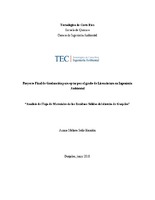Mostrar el registro sencillo del ítem
Análisis de flujo de materiales de los residuos sólidos del distrito de guápiles
| dc.contributor.author | Solís-Blandón, Ariana | |
| dc.date.accessioned | 2018-08-07T22:09:24Z | |
| dc.date.available | 2018-08-07T22:09:24Z | |
| dc.date.issued | 2018 | |
| dc.identifier.uri | https://hdl.handle.net/2238/9876 | |
| dc.description | Proyecto de Graduación (Licenciatura en Ingeniería Ambiental) Instituto Tecnológico de Costa Rica, Escuela de Química, 2018 | es |
| dc.description.abstract | Due to problems in solid waste management in the district of Guápiles, the use of the tool called "Material Flow Analysis" is considered, for the first time in Costa Rica. This tool allows to visualize the flows of solid waste within a system to identify the main existing problems based on the distribution of the masses of the materials in the final disposal sites defined by the population, as well as the various social actors involved in the process. In this way, it was possible to identify the total solid waste destined for burning (283.80 tons / year), burials of organic matter (1 204.89 tons / year), glass burials (4.71 tons / year), recovery of solid waste for recycling, including less common flows such as the recovery of electronic waste and scrap (2 115.35 tons / year) and the 7 408,04 tons / year destined to Los Laureles Sanitary Landfill, including 1 225,44 tons/ year of ilegal discharges. Using this tool, it is possible to make decisions based on the improvement of the solid waste management system that is provided in the district by the local government, and the private and informal sector, identified in the data collection process. | es |
| dc.language.iso | spa | es |
| dc.publisher | Instituto Tecnológico de Costa Rica | es |
| dc.rights | acceso abierto | es |
| dc.subject | Análisis | es |
| dc.subject | Quemas | es |
| dc.subject | Reciclaje | es |
| dc.subject | Gestión | es |
| dc.subject | Residuos | es |
| dc.title | Análisis de flujo de materiales de los residuos sólidos del distrito de guápiles | es |
| dc.type | proyecto fin de carrera | es |


